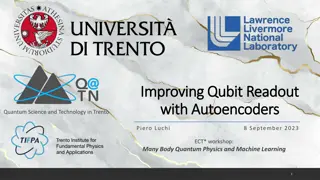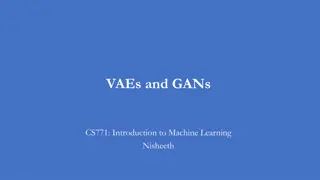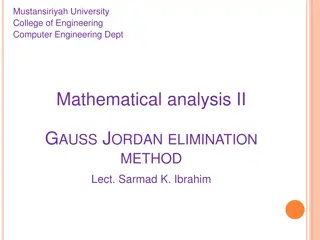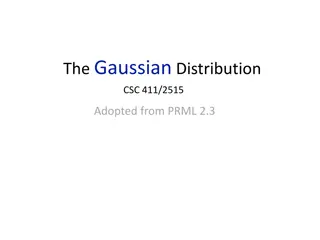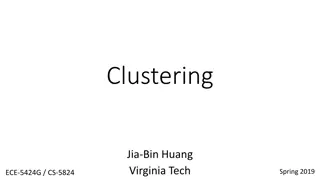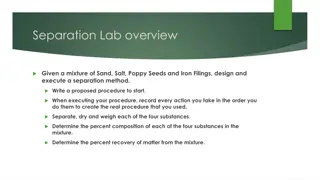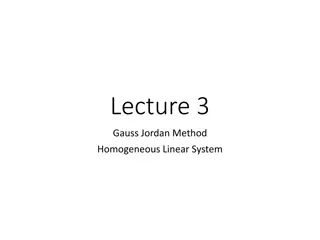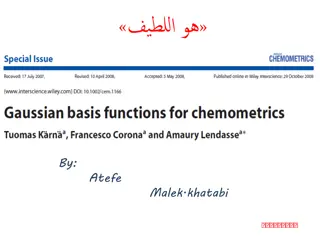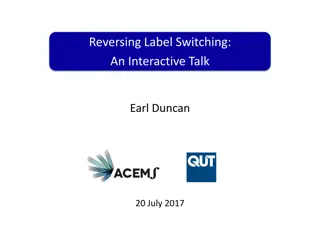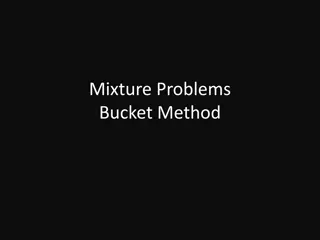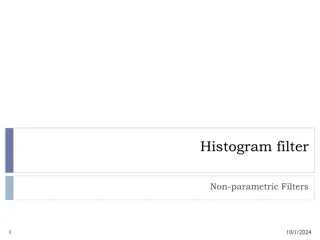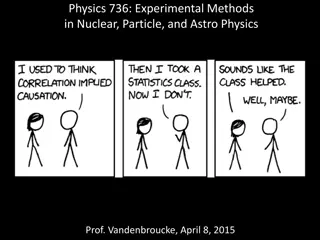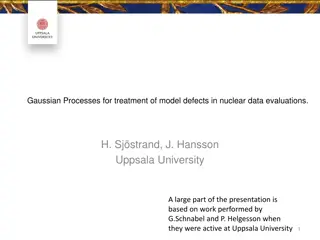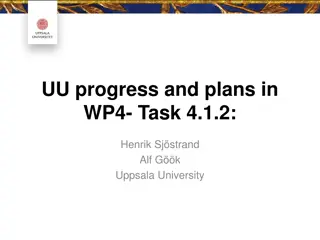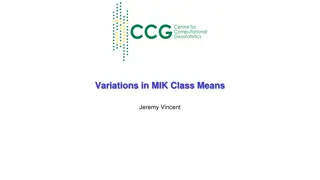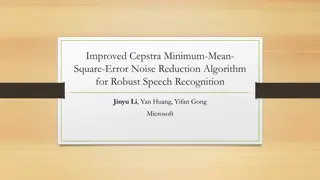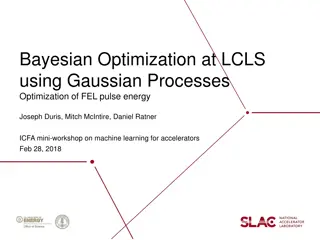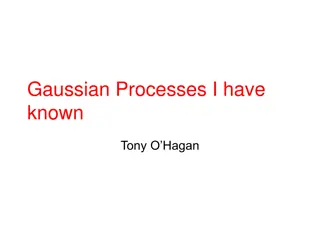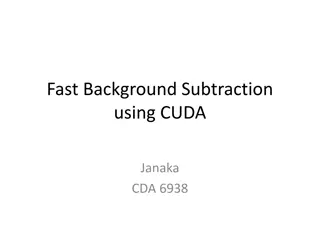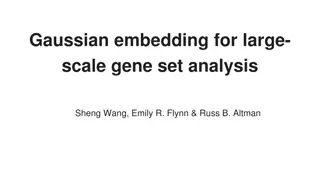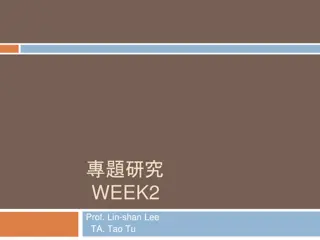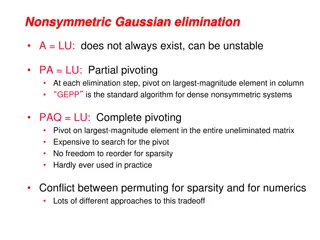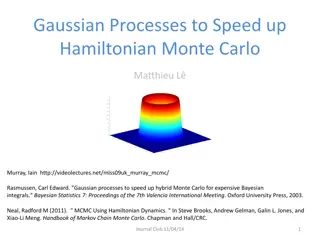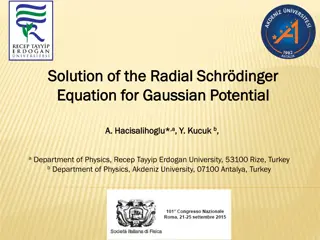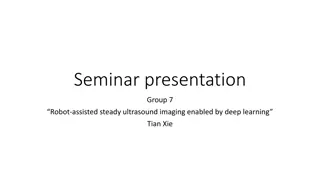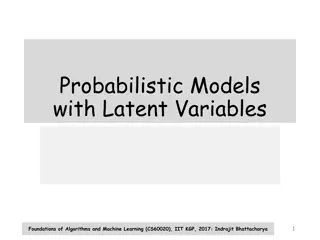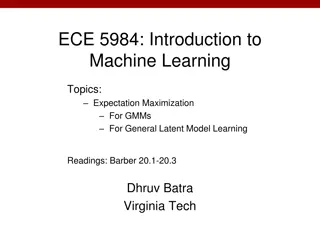System Models in Software Engineering: A Comprehensive Overview
System models play a crucial role in software engineering, aiding in understanding system functionality and communicating with customers. They include context models, behavioural models, data models, object models, and more, each offering unique perspectives on the system. Different types of system
6 views • 33 slides
Improving Qubit Readout with Autoencoders in Quantum Science Workshop
Dispersive qubit readout, standard models, and the use of autoencoders for improving qubit readout in quantum science are discussed in the workshop led by Piero Luchi. The workshop covers topics such as qubit-cavity systems, dispersive regime equations, and the classification of qubit states through
3 views • 22 slides
Unraveling the Gaussian Copula Model and the Financial Collapse of 2008
Explore the dangers of relying on the Gaussian copula model for pricing risks in the financial world, leading to the catastrophic collapse of 2008. Discover how the lure of profits overshadowed warnings about the model's limitations, causing trillions of dollars in losses and threatening the global
7 views • 18 slides
Variational Autoencoders (VAEs) and Generative Adversarial Networks (GANs) in Machine Learning
Introduction to Generative Models with Latent Variables, including Gaussian Mixture Models and the general principle of generation in data encoding. Exploring the creation of flexible encoders and the basic premise of variational autoencoders. Concepts of VAEs in practice, emphasizing efficient samp
0 views • 19 slides
Gaussian Elimination Method in Linear Algebra
Gaussian Elimination and Gauss-Jordan Elimination are methods used in linear algebra to transform matrices into reduced row echelon form. Wilhelm Jordan and Clasen independently described Gauss-Jordan elimination in 1887. The process involves converting equations into augmented matrices, performing
5 views • 14 slides
The Gaussian Distribution and Its Properties
This insightful content dives into the Gaussian Distribution, including its formulation for multidimensional vectors, properties, conditional laws, and examples. Explore topics like Mahalanobis distance, covariance matrix, elliptical surfaces, and the Gaussian distribution as a Gaussian function. Di
0 views • 19 slides
Overview of Unsupervised Learning in Machine Learning
This presentation covers various topics in unsupervised learning, including clustering, expectation maximization, Gaussian mixture models, dimensionality reduction, anomaly detection, and recommender systems. It also delves into advanced supervised learning techniques, ensemble methods, structured p
2 views • 37 slides
Mixture Separation Lab Procedure & Analysis
In this practical lab activity, students are tasked with separating a mixture containing Sand, Salt, Poppy Seeds, and Iron Filings. The procedure involves a step-by-step approach including identifying three separation strategies, executing the chosen method, recording observations, and calculating p
0 views • 6 slides
Overview of Sparse Linear Solvers and Gaussian Elimination
Exploring Sparse Linear Solvers and Gaussian Elimination methods in solving systems of linear equations, emphasizing strategies, numerical stability considerations, and the unique approach of Sparse Gaussian Elimination. Topics include iterative and direct methods, factorization, matrix-vector multi
0 views • 35 slides
Gaussian Elimination and Homogeneous Linear Systems
Gaussian Elimination is a powerful method used to solve systems of linear equations. It involves transforming augmented matrices through row operations to simplify and find solutions. Homogeneous linear systems have consistent solutions, including the trivial solution. This method is essential in li
0 views • 16 slides
Functional Approximation Using Gaussian Basis Functions for Dimensionality Reduction
This paper proposes a method for dimensionality reduction based on functional approximation using Gaussian basis functions. Nonlinear Gauss weights are utilized to train a least squares support vector machine (LS-SVM) model, with further variable selection using forward-backward methodology. The met
0 views • 23 slides
Gaussian Statistics and Confidence Intervals in Population Sampling
Explore Gaussian statistics in population sampling scenarios, understanding Z-based limit testing and confidence intervals. Learn about statistical tests such as F-tests and t-tests through practical examples like fish weight and cholesterol level measurements. Master the calculation of confidence i
0 views • 8 slides
Fast High-Dimensional Filtering and Inference in Fully-Connected CRF
This work discusses fast high-dimensional filtering techniques in Fully-Connected Conditional Random Fields (CRF) through methods like Gaussian filtering, bilateral filtering, and the use of permutohedral lattice. It explores efficient inference in CRFs with Gaussian edge potentials and accelerated
1 views • 25 slides
Label Switching in Bayesian Mixture Models
In the interactive talk "Reversing Label Switching" by Earl Duncan, the concept of label switching in Bayesian mixture models is explored. Label switching poses challenges in making accurate inferences due to symmetric modes in posterior distributions. Duncan discusses conditions for observing label
1 views • 13 slides
Solving Mixture Problems Using the Bucket Method
Mixture problems occur in various scenarios like blending goods for sale or obtaining desired solutions. The bucket method involves setting up buckets with starting values, additive values, and the desired mixture to solve equations efficiently. An example problem is demonstrated step-by-step for cl
1 views • 12 slides
Advanced Emission Line Pipeline for Stellar Kinematics Analysis
This comprehensive pipeline includes processes for stellar kinematics, continuum fitting, Gaussian line fitting, and analysis of SAMI-like cubes. It also covers Gaussian fitting techniques, parameter mapping, and potential issues. The pipeline features detailed steps and strategies for accurate anal
0 views • 10 slides
Robot Localization Using Kalman Filters
Robot localization in a hallway is achieved through Kalman-like filters that use sensor data to estimate the robot's position based on a map of the environment. This process involves incorporating measurements, updating state estimates, and relying on Gaussian assumptions for accuracy. The robot's u
1 views • 26 slides
Statistical Distributions in Physics
Exploring the connections between binomial, Poisson, and Gaussian distributions, this material delves into probabilities, change of variables, and cumulative distribution functions within the context of experimental methods in nuclear, particle, and astro physics. Gain insights into key concepts, su
0 views • 13 slides
Gaussian Processes for Treatment of Model Defects in Nuclear Data Evaluations
Gaussian Processes (GP) are explored for treating model defects in nuclear data evaluations. The presentation discusses the impact of model defects on evaluation results and proposes using GP to address these issues. The concept of GP and its application in treating model defects are detailed, highl
2 views • 28 slides
Enhancing Nuclear Data Evaluation with Gaussian Processes
Uppsala University is investing efforts in developing the TENDL methodology to incorporate model defect methods for nuclear data evaluations. By leveraging Gaussian Processes and Levenberg-Marquardt algorithm, they aim to improve the accuracy and reliability of calibration data to produce justified
0 views • 16 slides
Analyzing Variations in MIK Class Means by Jeremy Vincent
The presentation delves into the MIK estimator, exploring its impact on estimation with constant class means and non-Gaussian data. Review of initial results, examination of class mean bias in upper tail, and implications for metal containment are discussed. Cross-validation study findings, future w
1 views • 9 slides
Improved Cepstra Minimum-Mean-Square-Error Noise Reduction Algorithm for Robust Speech Recognition
This study introduces an improved cepstra minimum-mean-square-error noise reduction algorithm for robust speech recognition. It explores the effectiveness of conventional noise-robust front-ends with Gaussian mixture models (GMMs) and deep neural networks (DNNs). The research demonstrates the benefi
1 views • 43 slides
Bayesian Optimization at LCLS Using Gaussian Processes
Bayesian optimization is being used at LCLS to tune the Free Electron Laser (FEL) pulse energy efficiently. The current approach involves a tradeoff between human optimization and numerical optimization methods, with Gaussian processes providing a probabilistic model for tuning strategies. Prior mea
1 views • 16 slides
Gaussian Processes: A Comprehensive Overview
Gaussian Processes (GPs) have wide applications in statistics and machine learning, encompassing regression, spatial interpolation, uncertainty quantification, and more. This content delves into the nature of GPs, their use in different communities, modeling mean and covariance, as well as the nuanc
0 views • 50 slides
Reservoir Modeling Using Gaussian Mixture Models
In the field of reservoir modeling, Gaussian mixture models offer a powerful approach to estimating rock properties such as porosity, sand/clay content, and saturations using seismic data. This analytical solution of the Bayesian linear inverse problem provides insights into modeling reservoir prope
0 views • 10 slides
Fast Background Subtraction Using CUDA: Accelerating Foreground Detection
Background subtraction is a vital step in computer vision, enabling the identification of foreground pixels in dynamic scenes. Traditional methods face challenges due to illumination changes, camera issues, and background object variations. Current approaches like Gaussian Mixture Models (GMM) offer
1 views • 26 slides
Gaussian Embedding for Large-Scale Gene Set Analysis
Gene sets in various downstream analyses such as disease signature identification, drug pathway association, survival analysis, and drug response prediction come from diverse sources and play a crucial role in boosting the signal-to-noise ratio. Gaussian embedding is utilized to model uncertainty, p
0 views • 14 slides
Speech Recognition and Acoustic Modeling
This presentation delves into the world of speech recognition, covering topics such as Hidden Markov Models, feature extraction, acoustic modeling, and more. Explore the essential elements of processing speech signals, linguistic decoding, constructing language models, and training acoustic models.
0 views • 34 slides
Nonsymmetric Gaussian elimination
Intricacies of nonsymmetric Gaussian elimination, LU factorization, partial pivoting, left-looking column LU factorization, symbolic sparse Gaussian elimination, column preordering for sparsity, and more in numerical linear algebra algorithms.
0 views • 28 slides
Gaussian Processes to Speed up Hamiltonian Monte Carlo
Bayesian inference, Metropolis-Hastings, Hamiltonian Monte Carlo, and Markov Chain Monte Carlo are explored in the context of sampling techniques and estimation of probability distributions in complex models. The use of Gaussian processes to enhance the efficiency of Hamiltonian Monte Carlo is discu
0 views • 14 slides
Radial Schrödinger Equation Solution for Gaussian Potential
Energy eigenvalues and eigenfunctions in quantum mechanics are studied through the exact solution of the radial Schrödinger equation for Gaussian potentials, using the Asymptotic Iteration Method. The method's efficiency in solving wave equations for different potentials is highlighted, with a focu
0 views • 23 slides
Acoustic Modeling and Hidden Markov Model in Speech Processing
This content presents a detailed overview of acoustic modeling, featuring concepts like feature extraction, Gaussian mixture models, and solving basic problems in speech processing. It also delves into Hidden Markov Models, their elements, and practical applications in speech recognition systems.
0 views • 30 slides
Seminar presentation
This project focuses on developing a robot-assisted steady ultrasound imaging system using deep learning techniques. The aim is to address challenges in imaging real tissue with non-random scatterer configurations, where traditional models may fall short. By employing Gaussian Process and motion est
0 views • 21 slides
Gas Mixture Partial Pressures Calculation
Given a gas mixture with different partial pressures of CO2, Ar, O2, and helium, calculate the total pressure of the mixture. The total pressure is 745 mmHg, with partial pressures of CO2 at 125 mmHg, Ar at 214 mmHg, and O2 at 187 mmHg. Determine the partial pressure of helium gas in the mixture usi
0 views • 17 slides
Gaussian Processes: Understanding Nonparametric Regression
Learn about Gaussian processes and their use in nonparametric regression, exploring concepts like multivariate normal distributions, covariance matrices, and Bayesian parameter estimation. Gain insights into the advantages and applications of Gaussian distributions in modeling complex data.
1 views • 30 slides
Gaussian Mixture Model and EM Recitation Overview
Explore the concepts of Gaussian Mixture Model (GMM) and Expectation Maximization (EM) through recitation slides covering motivation, formulation, definitions, and detailed steps of EM algorithm. Understand how GMM works as a distribution and dive into the intricacies of EM for inference and learnin
0 views • 14 slides
Introduction to Independent Component Analysis in Math
Explore the concept of Independent Component Analysis (ICA) in this informative project presentation. Learn about the Cocktail Party Problem, ICA model, Fast ICA algorithm, and more. Discover the motivation behind ICA and the process of estimating original speech signals. Understand the principles a
0 views • 23 slides
Foundations of Probabilistic Models with Latent Variables
Explore the foundations of probabilistic models with latent variables in algorithms and machine learning. Learn about density estimation, latent variables, generative mixture models, and tasks in a mixture model. Discover concepts like unsupervised learning, sub-populations, and parameter estimation
0 views • 29 slides
Gaussian Distribution: Characteristics and Derivations
Explore the Gaussian distribution, an approximation of the binomial and Poisson distributions, exhibiting a bell-shaped curve with characteristics like mean estimation and probability density function. Learn about the continuous nature, interval definition, and full-width at half maximum of the Gaus
0 views • 25 slides
Introduction to Expectation Maximization for General Latent Model Learning
Explore the concepts of Expectation Maximization for Gaussian Mixture Models and general latent model learning in ECE 5984. Delve into topics such as K-means clustering and poster presentations, with insights from readings by Barber and contributions from Dhruv Batra at Virginia Tech.
0 views • 38 slides

